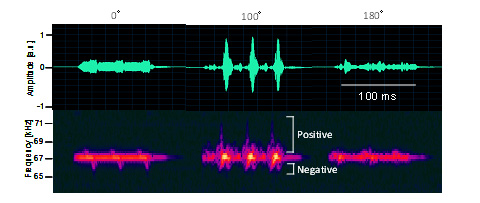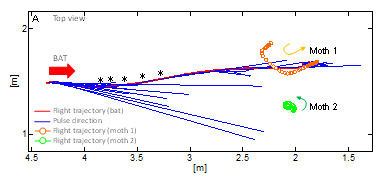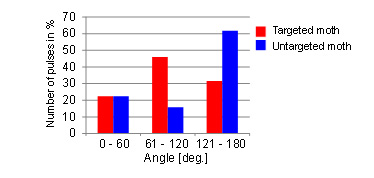
Figure 1: Amplitude pattern (top) and spectrogram (bottom) of the echoes returning from a fluttering moth. The moth was oriented at 0 degrees, 100 degrees and 180 degrees relative to the sound source.
Yuki Kinoshita – dmm1014@mail4.doshisha.ac.jp
Shizuko Hiryu – shiryu@mail.doshisha.ac.jp
Doshisha University
Popular version of paper 1pAB6
Presented Monday afternoon, June 3, 2013
ICA 2013 Montreal
Echolocation behavior of bats adapts to hunt insect prey, i.e., changing duration and frequency of emitted pulse to effectively obtain information about the targets from returning echoes. For example, bats can detect faint echoes from a small target prey. Some previous studies suggested that bats use the acoustical information obtained from fluttering insects encoded both in frequency and amplitude modulations of the echoes (acoustical glints) to detect and even identify or classify the insects (H.-U. Schnitzler and Flieger, 1983; H. U. Schnitzler and Ostwald, 1983; von der Emde and Menne, 1989; von der Emde and Schnitzler, 1991; H. U. Schnitzler and Kalko, 2001; H. U. Schnitzler and Denzinger, 2011).
Here, echoes from fluttering moths (Goniocraspidumpryeri) were investigated by using artificial sounds to estimate how the acoustical features of the echoes coming back from fluttering moths changed with the incident angle of echolocation pulses emitted by the bats during prey capture flight. We then investigated the prey pursuit behavior of Japanese horseshoe bats, Rhinolophus ferrumequinum Nippon, while the bats were tasked to make a choice between two tethered fluttering moths during flight in a chamber. The echolocation sounds were recorded using a telemetry microphone (Telemike) that was mounted on the bats, combined with a 2-D microphone array system arranged in the chamber. We investigated how the bats changed the direction and beam width of emitted pulses during the target selection task, considering changes in acoustical glints of echoes coming back from the moths.
Figure 1 shows the amplitude pattern and spectrogram of the echo returning from the fluttering moths that were oriented at 0 degrees, 100 degrees and 180 degrees relative to the sound source. Echoes returning from the fluttering G. pryeri were amplitude-modulated, showing periodic peaks (amplitude glints: top panel in Fig. 1). In addition, positive and negative Doppler shifts (spectral glints) of approximately +/- 1 kHz were repeated in synchronization with the wing beat cycle of the moths (bottom panel). The amount of amplitude glints showed a maximum approximately between 70 degrees and 100 degrees whereas the minimum was around 140 degrees. The amplitude modulation is maximum when the reflective area is the largest, and this corresponds to the wing area located on the side of the moth's body.

Figure 1: Amplitude pattern (top) and spectrogram (bottom) of the echoes returning from a fluttering moth. The moth was oriented at 0 degrees, 100 degrees and 180 degrees relative to the sound source.
When the experimenter released the bat in the flight chamber, the bat started to approach the fluttering and tethered moth. Figure 2 shows representative flight paths of the bats (red line) and of the moths (orange and green plots). The bat frequently shifted its attention between moth 1 and moth 2 during emissions of these long duration pulses (asterisks), i.e., some pulses were emitted toward moth 2 before pulse directions were aimed to the target direction of moth 1 which was finally captured.

Figure 2: Representative flight paths of the bat and moths during moth capture flight.
Horizontal flight trajectories of the bat (red line) and two moths (orange and green plots).
1.5 s prior to the capture, the echoes from moth 2 were assumed to be stronger than those from moth 1 because moth 2 directed within the angles that produced strong acoustic glints (70 degrees and 100 degrees). At this moment, the bat directed it pulse direction toward moth 2. When the moth 1 turned to the angles within 70 degrees– 100 degrees, the bat shifted the pulse direction from moth 2 to moth 1, with consecutive emissions of a long pulse. Figure 3 shows the comparison between the angles of the bat flight direction relative to its targeted (pulse direction was aimed) and untargeted moths at the time of pulse emission. The biggest probability for the moth to be targeted by the bat was when its flying direction ranged the angles within 60 degrees;–120 degrees relatively to the bat pulse direction, which includes the angles of 70 degrees–100 degrees. These findings suggest that the bats are more attracted to the prey returning the strongest echoes during target selection task.

Figure 3: The angle of moth to bat compared between targeted and untargeted moths.